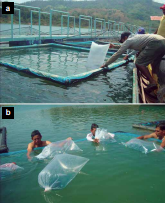Use of reservoirs for fish farming
Abstract
The rapid growth of the world population, as well as climatic variations, have had an impact on the increase in the demand for water, that is why it is necessary to plan, control and manage this essential element for life. Thus, reservoirs constitute a valuable infrastructure, since they serve to store the water that comes mainly from basins fluvial and rains.
These reservoirs represent an important resource to be administered for different uses in a way suitable, for example, for irrigation in the agriculture, flood control, generation of energy for domestic and industrial use, recreation and in some cases and not least, for the improvement of plant and animal ecology, as well as well as the development of fish farming.
References
González, J. y B. Heredia. 1998. El cultivo de la cachama (Colossoma macropomum). Segunda Edición. Maracay, Venezuela. 134 p.
González, E. J., M. Ortaz, C. Penaherrera, y M. Matos. 2004. Fitoplancton de un embalse tropical hipereutrófico (Pao-Cachinche, Venezuela): abundancia, biomasa y producción primaria. INCI [online]. Vol.29, N°.10 [citado 2015-05-22], 548-555 pp. Disponible en: . ISSN 0378-1844.
Mora, J. 1994. Cultivo de Colossoma macropomum en jaulas flotantes en el embalse El Pao-La Balsa, estado Cojedes (Doctoral dissertation, Tesis de Maestría. Decanato de Postgrado. Universidad Simón Bolívar (USB). Estado Miranda, Venezuela. Mem. VIII Congr. Latinoam. Acuic.: 409-415 pp).
Pérez, L y G. Martino. 1989. Análisis microeconómico del cultivo de Cachama (Colossoma sp.), en jaulas flotantes, Guayana, Venezuela. 65-205 pp. En J.R. Juárez-Palacios Editores. Avances en el cultivo de peces del género Colossoma, Documento de Campo Nº 5, AQUILA/FAO-Italia, Brasilia, Brasil.
Revista El Agua Tomo I Edición Especial Grandes Presas de Venezuela. Ministerio del Ambiente y de los Recursos Naturales Renovables – 1995 Bibliografía: CD-ROM Multimedia “Atlas de Venezuela en Línea” de Cartografía Nacional. www.edicionesmultimedia. Com


